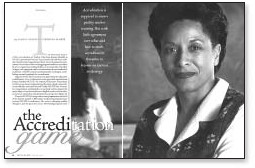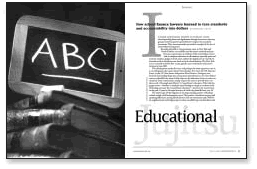The AFT responds
The American Federation of Teachers’ report Do Charter Schools Measure Up? has been sharply criticized by special-interest groups advocating on behalf of charter schools. In “Lobbying in Disguise” (Check the Facts, Winter 2003), Robert Maranto joins this discordant chorus. But Maranto and the AFT agree on a number of points:
• Charter schools are no panacea, and legitimate concerns exist about the effectiveness of for-profit education.
• Charter schools generally do not cream off brighter students.
• The achievement of students in charter schools has not lived up to expectations.
• Charter schools are not hothouses of innovation. Instead, they modify and disseminate existing reform practices to a greater degree than other public schools.
• Charter schools employ many inexperienced teachers at pay that is competitive with other public schools. However, senior charter school teachers often are paid less than their public school counterparts. Virtually all are at-will employees.
• Charter schools are somewhat more likely to use merit pay, although the practice is fairly limited. Most use a traditional salary schedule.
The AFT report states that charter schools do spend less money than other public schools. However, Maranto implies that we think charter schools are underfunded. In fact, the AFT study finds “general funding comparability,” even though charter schools receive less funding for facilities. Public schools spend more than charter schools because public schools do more. School districts bear higher costs for special education, low-income students, transportation, and food services, as well as activities not typically found in charter schools, such as community outreach, services to private schools, and adult education.
Despite our many areas of agreement regarding charter schools, three fundamental differences remain.
First, the evidence does not suggest that parental choice and market competition necessarily lead to improved student achievement. In November 2002 the Texas Education Agency ordered the shutdown of five charter schools (all open for at least three years), citing persistent low academic performance. Despite the poor track record of these schools, large numbers of students were still enrolled.
Second, the AFT does not believe that parental satisfaction surveys are a substitute for student achievement. Surveys do not include the large number of families who leave charter schools-some of whom are presumably dissatisfied. Furthermore, as the surveys performed by Phi Delta Kappa reveal, parents consistently give high ratings to the public schools their children attend.
Third, Maranto is not persuaded by the research cited in our report showing that charter schools have had only a limited competitive effect on other public schools. Yet in “Small Districts in Big Trouble: How Four Arizona School Systems Responded to Charter Competition,” a study cited in the AFT report, Maranto and his colleagues found “that market competition varies depending on local environments.” Our review of the research revealed few examples of charter schools’ having an impact on districts that could be attributed to market forces.
Finally, we are attacked for our recommendation that policymakers “should not expand charter school activities until more convincing evidence of their effectiveness and viability is presented.” Is this an extreme position taken because of union politics? We don’t think so. It doesn’t differ from the Thomas B. Fordham Foundation’s decision, regarding its investment of more than $1 million in charter schools in Dayton, Ohio, to shift “our efforts from starting charter schools to ensuring that they are effective. We intend to develop outside services that will help struggling schools improve their business management operations, their delivery of special education, and, we hope, their academic results.”
Joan Baratz-Snowden
Joan Devlin
American Federation of Teachers
Washington, D.C.
Robert Maranto responds: Alas, the AFT still seems to be spinning the facts. They cite the Thomas B. Fordham Foundation in support of their proposed moratorium on the opening of new charter schools, yet the foundation strongly favors further national expansion of charter schools. There is a world of difference between one organization’s decisions to focus on its existing investments and a decision to place a nationwide moratorium on the opening of new schools. In fact, foundation president Chester E. Finn Jr. wrote that the AFT’s report “reeks of error, distortion, and untruth about charter schools.”
Further belying the AFT’s logic is the fact that 18 percent of Dayton public school children now attend charters, about 15 times the national average. Would the AFT agree that charter growth should slow only when they enroll 18 percent of American public school students?
The AFT seems to have misinterpreted my own work. My team of researchers did in fact find that “market competition varies depending on local environments.” But this is a long way from saying that charters have had no effect. The point was that competition was most effective in areas where a fair number of charter schools had sprouted up. Arizona school districts where a significant number of children left for charter schools responded with leadership changes and other attempts to draw students back to the district.
Whether charters are hothouses of innovation depends on definitions. If innovation means inventing something never before seen on Earth, then few schools of any kind innovate. Yet charters do make “innovative” options available to parents who want them. Montessori education is 100 years old, yet public school officials have told me that “not in 100 years” will my local school system (which spends more than $19,000 per child) offer a Montessori option-it’s too innovative for us. I wish I had a charter option!
Sandra Vergari and Frederick M. Hess (“The Accreditation Game,” Feature, Fall 2002) make some inaccurate claims about the National Council for Accreditation of Teacher Education (NCATE). They are simply mistaken in saying that NCATE’s standards are “mainly input driven.” NCATE’s standards focus on results. Does the teacher know his or her subject matter, and can the teacher teach effectively? That is the evidence that NCATE demands of its accredited institutions.
The authors question “whether any form of accreditation is useful or appropriate in a context of widespread disagreement about what skills, dispositions, and methods are essential to good teaching.” But there can never be consensus about the one right way to teach a unique group of individuals. Vergari and Hess mention discipline, desk arrangement, spelling and grammar, and other areas where “one best way” has not been decided. Let’s hope it never will be! Children are individuals, and individuals learn differently. Some strategies work with some children better than with others-hence, different outcomes with different children. The competent teacher, with a base of knowledge about teaching and learning, makes the decision about what works best with her group of students.
Common sense and experience indicate that there is nothing unique about teaching that suggests its practitioners should be prepared differently from other licensed professionals such as doctors, engineers, accountants, and pilots. Teachers should know how children learn, should be aware of the available research in their specialties, and should be able to apply that research to their practice.
Vergari and Hess also deride the largest national study ever done on teachers’ qualifications, completed in 1999 by the Educational Testing Service. The study examined the Praxis II scores of 270,000 test takers and found that 91 percent of graduates of NCATE-accredited institutions pass state licensing exams across the nation-18 percentage points higher than graduates of non-NCATE institutions. These are exams of subject matter knowledge, proving that content knowledge is at the top of the agenda at NCATE-accredited institutions. ETS concluded, “NCATE-accredited institutions appear to increase the likelihood that candidates will meet state licensing requirements.”
Arthur E. Wise
President, NCATE
Washington, D.C.
There is no question that, as Michael Heise argues, the accountability and standards movement is threatened by school finance litigation (“Educational Jujitsu,” Feature, Fall 2002). Plaintiffs in these lawsuits say they favor high standards and accountability and then point to data showing that large numbers of students in urban districts fail to meet heightened standards. Then they cite statements like “all students can meet the standards,” issued by state departments of education, to support their demands for more money from the courts.
How, then, can states pursue and implement a reform agenda if they are also involved in school finance litigation? The answer is for states to vigorously defend such cases in order to avoid ceding control over education policy to plaintiffs and the courts. All too often these important cases are given little attention by states until it is too late.
These cases can be won if they are properly defended. The recent New York City school finance case is a prime example. Despite tremendous political pressure, New York governor George Pataki defended the case and ultimately prevailed at the appeals-court level (full disclosure: my firm served as co-counsel with the New York attorney general’s office in the trial of the Campaign for Fiscal Equity lawsuit). Although the plaintiffs have appealed the decision, for now the governor and legislature have retained their ability to set education policy and to determine spending priorities. And the New York City public schools, rather than extracting and then wasting more of the taxpayers’ money, may be forced to finally move beyond “lack of money” excuses and attempt to implement real, research-based reforms.
In too many places, public officials do not appreciate the stakes in school finance litigation or erroneously believe that such litigation will hasten reform efforts. Heise makes a compelling case that such litigation does not hasten reform, but hampers it.
Rocco E. Testani
Sutherland Asbill & Brennan LLP
Atlanta, Georgia
Social factors
David Murray’s critique (“Waiting for Utopia,” Check the Facts, Summer 2002) of scholar Richard Rothstein’s writings stimulates an important question: To what degree can formal education mitigate the debilitating social and physical conditions that accompany low-income students to school?
Rothstein continually asks whether schooling is the most effective way to elevate students from poverty and launch them on a road to higher academic achievement.
Answers to this question can be tightly linked to values and, thus, heavily freighted with political rhetoric. This is the manner in which Murray has chosen to treat the topic. He attacks Rothstein’s writings as though they were part of a political campaign.
Here is the broad context in which the issue can be nested. Europe has long seen fit to invest heavily in income maintenance, public housing, universal medical coverage, prenatal care, and preschool and childcare policies in an effort to compensate for deficiencies in the family and community environments of students.
The United States has opted to rely more heavily on schooling as a means for promoting individual fulfillment, enhancing social justice, and countering unearned privilege.
Which strategy is more effective? In western Europe, it has resulted in fewer citizens residing at the extremes of wealth and poverty. Hence, if the standard is equality, western Europe wins.
However, if greater economic dynamism, more powerful incentives for creativity, cultural innovation, greater opportunity for material comfort, greater acceptance of diversity, and greater personal liberty are taken as measures of societal well-being, then the United States might be better.
The United States presently spends approximately $3 billion each operating day to support its schools and colleges. On an annualized basis, this is more than the cost of America’s national defense.
If, under the best of conditions, schools are still incapable of adding anything but a few fractions of a standard deviation to the academic achievement of students or to their lifetime earning trajectories, might it not make sense to freeze school spending and explore supplementary policy instruments? Might it not make sense to focus on other social interventions that might have a more powerful effect on students’ cognitive skills?
James W. Guthrie
Vanderbilt University
Nashville, Tennessee




